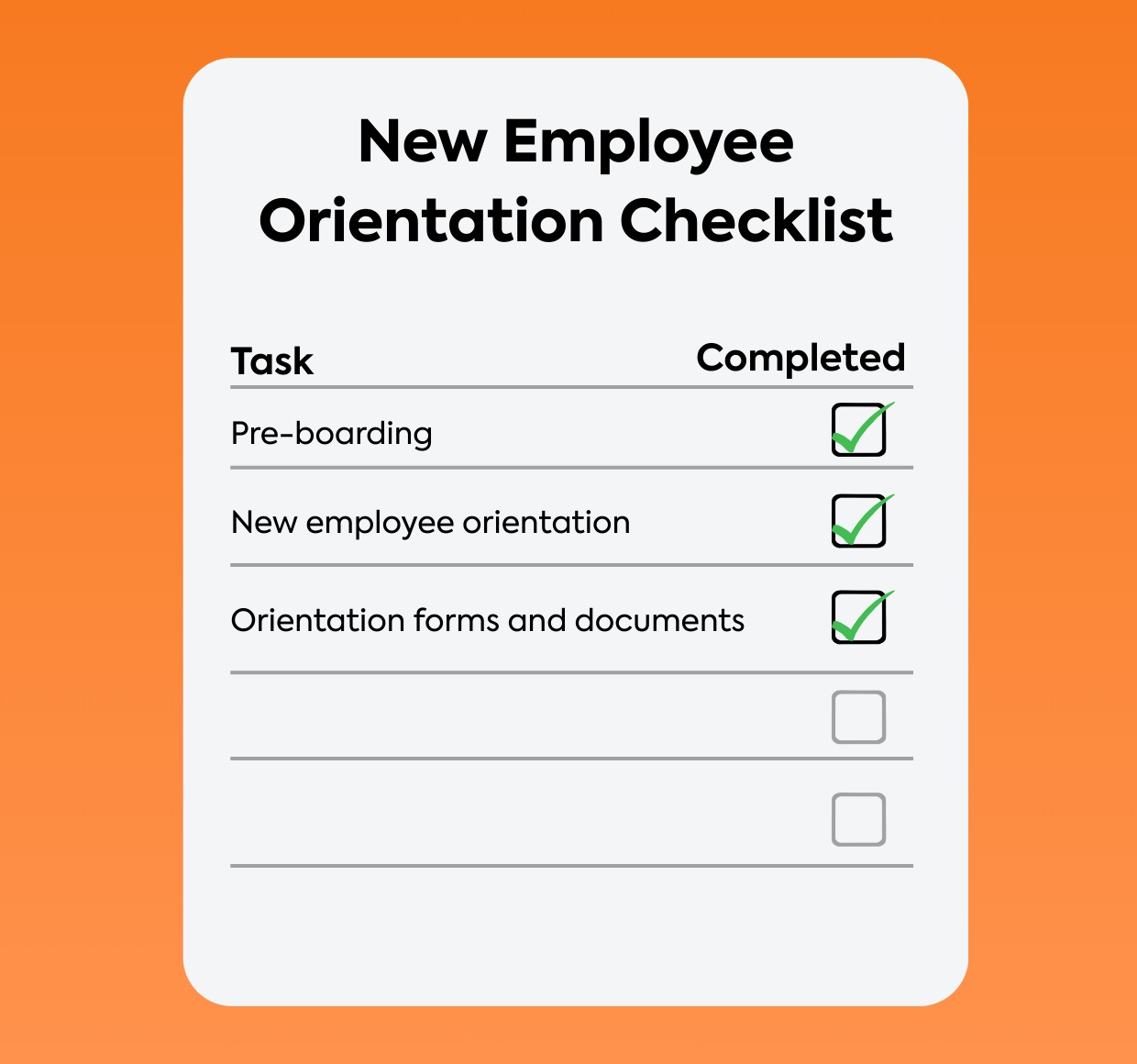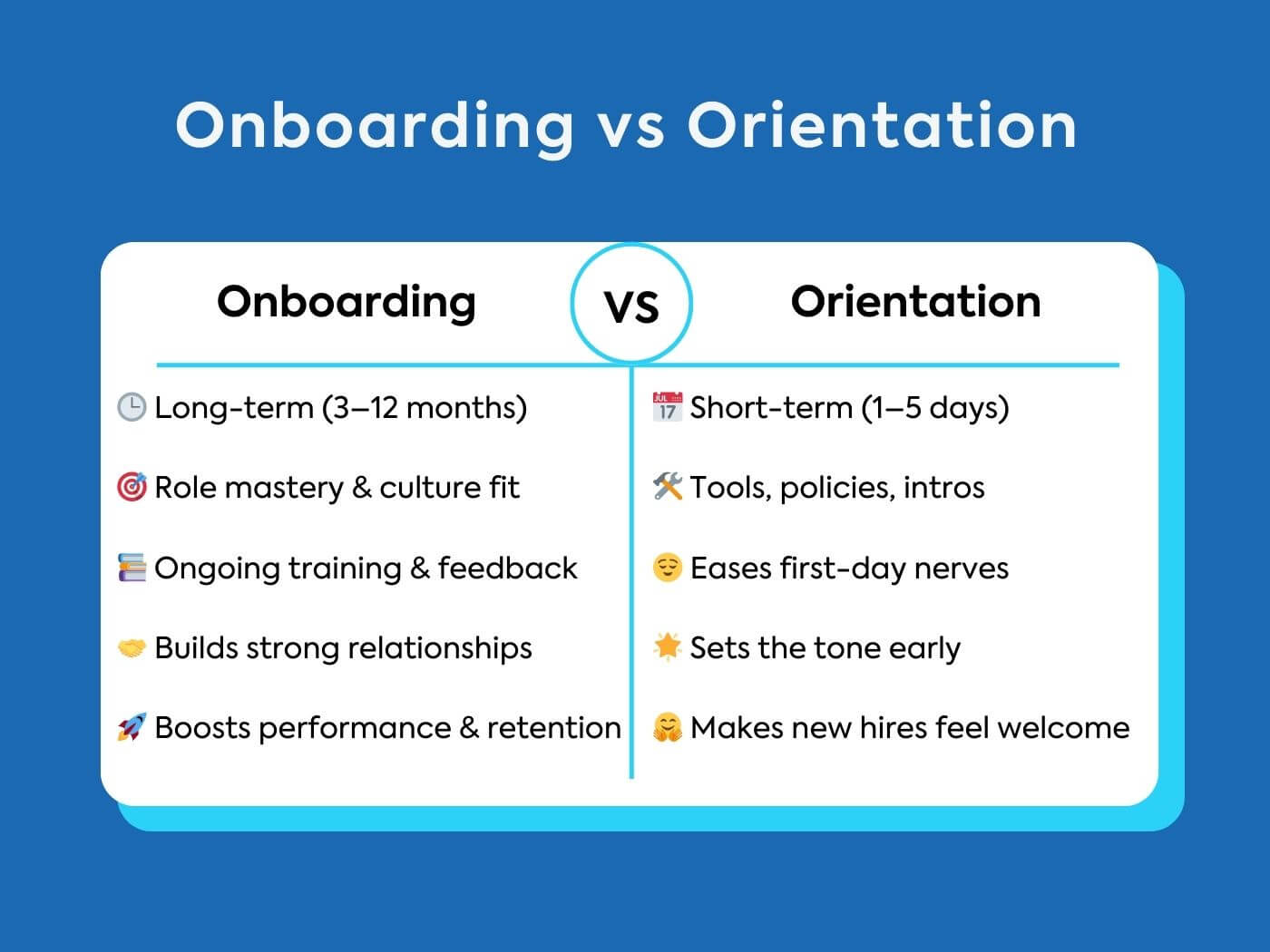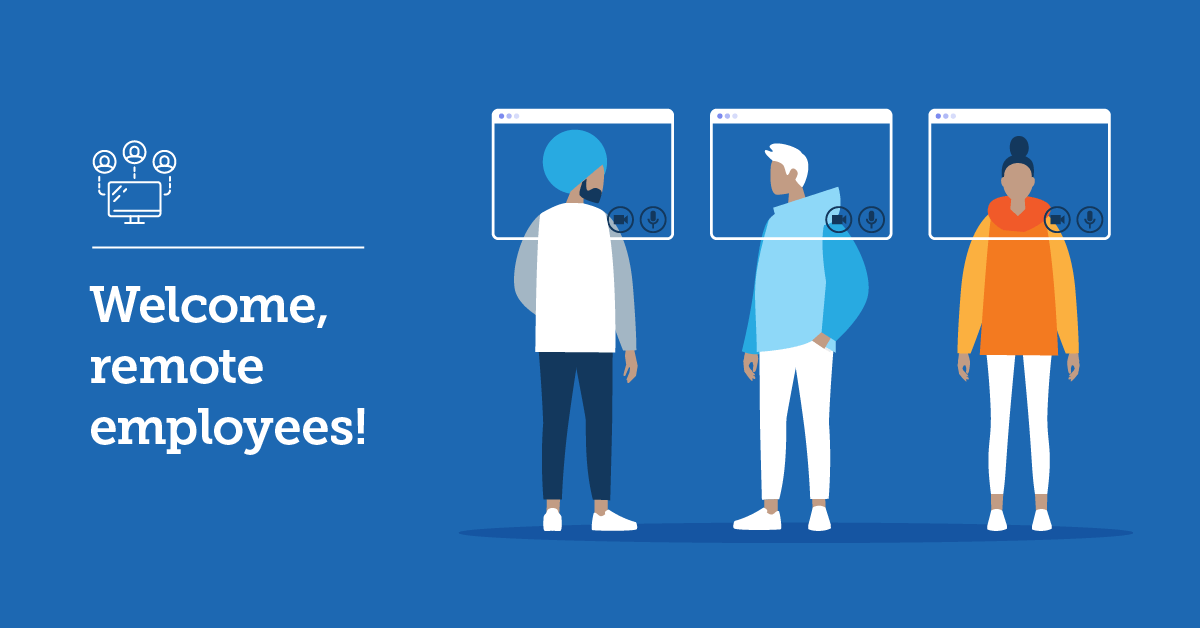- What is new employee orientation?
- The difference between orientation and onboarding
- Get your new hire orientation template
- New employee orientation ideas
- The benefits of the new employee orientation process
- What should a new employee orientation program include?
- 10 best practices for new employee orientation
- Frequently asked questions
- Culture add not culture fit
During new employee orientation (within a week of starting at a new company) 23% of new hires cry, according to a 2023 BambooHR survey. Plus, 44% have second thoughts about their move. Not a great start to a job. And one that has long-lasting effects. Because general research is clear. Retention and productivity rates skyrocket when new employee orientation provides a positive launchpad. When it doesn’t, new hires leave, and businesses suffer the consequences.
But what clinches the deal, is that nearly two-thirds of employees agree first impressions stick according to the same survey. Which brings us back to new employee orientation. New hire orientation represents a small, but mighty, window of opportunity. It’s the early, make-or-break part of the employee onboarding process. And it carries the weight of ongoing onboarding success in its hand.
So, how do you prevent tears and ensure it’s on point?
What follows here is a complete, new employee orientation guide. It contains practical strategies to help plan and streamline your new hire orientation program today and tomorrow. There are best practice tips you can adapt to suit your organization. Plus, there’s a comprehensive checklist you can use to standardize the employee onboarding process. And make sure all of the important bases are covered, every time.
What is new employee orientation?
Part of onboarding, a new employee orientation process serves a dual purpose. There’s the practical side, which focuses on workflows, people, and performance. Then there’s the emotional side, which targets motivation, meaning, and mindset.
Let’s look at the practical aspect first. During new hire orientation, an employee should learn more about their role, who they’ll be working with, and how their new company operates. With the skills, tools, and support they need to get started, this ‘how to’ focus puts them on the right path to reach their potential.
Many companies view orientation purely as this. As an administrative process, where employees become familiar with the rules, sign their contracts, and get to work.
But new employee orientation also needs to include elements associated with building engagement. It needs to mentally and emotionally integrate employees into an organization. Which means? Sharing company values. Showing new hires how they can make a meaningful contribution to the overall vision. And finding personal ways of making them feel warm, welcome, and wanted.
The difference between orientation and onboarding
The terms ‘orientation’ and ‘onboarding’ are often used interchangeably. But, really, they’re two separate concepts. And you need both.
The differences between the two? Simply put, it comes down to duration and detail.
A definition of onboarding
The employee onboarding process is ongoing. It starts as soon as an applicant accepts an offer. And it ends once they’re fully trained up, immersed in their role, and firmly embedded into your company’s culture and workflows. The purpose of onboarding is to provide a deep dive. It typically includes varied and timely training, combined with on-the-job experiences that give employees deeper insights into your company and their job. During onboarding, new hires form bonds with team members and connect with wider groups of stakeholders. They start having ideas and suggestions. And discover ways, not just to perform their jobs, but to improve their performance. All of this takes time. (Research has found that the socialization process alone can take up to a year.) So, some companies roll this out over a full 12 months. For others, it may drop to 90 days. Either way, most HR teams agree best practice is to spend no less than three months.
A definition of new employee orientation
Compared to this, new employee orientation is a short-lived event that fits within the bigger employee onboarding process. It starts on an employee’s first day at work. And lasts anything from a day to a week. There’s no formal or fixed timescale for new employee orientation. Duration will depend on the role in question, your company approach, and your industry. Some sectors, for example, will have different levels of training required before new employees can fully participate in their responsibilities.
But the key to new employee orientation is to get the balance right, and to keep it light. As we’ve mentioned, it needs to create a positive and comforting vibe. Spend too much time, and go into too much detail, and you risk overwhelming your new intake.
(TL;DR)
Get your new hire orientation template
HR may plan an effective new hire orientation program, but its delivery and execution involves a team of people. So, how do you ensure that everyone (including your new hire) does what they need to do, when they need to do it? The answer is to use a new employee orientation checklist. A complete list of activities assigned to the relevant people, use this new hire orientation checklist to:
- track an employee’s progress through orientation
- standardize the process
- spot any orientation tasks that haven’t been completed.
To give you a head start, as part of this new employee orientation guide, we’ve created a new hire orientation checklist template to work from. It includes tasks and activities you need to include in your new employee orientation program. Plus, a preboarding checklist to make sure you’ve put all the relevant plans in place before the big day. Just download, save, and adapt it to suit your own needs. Looking for ways to keep in touch with new hires during the onboarding process as a whole? We’ve also got 10 templates you can use to streamline your communication.
Pro tip: There’s a column for remote workers on each new hire orientation checklist. This highlights where the process may differ for new hires not based in the office. And provides tips on how to make alternative provision.
Email templates: Training invitation
New employee orientation ideas
Of course, the modern workplace is changing. And technology, specifically AI generative tech, is transforming workflows and upending training. So, what should companies do to keep new employee orientation current and competitive in 2024? Below are effective new hire orientation ideas you should consider when planning your new employee orientation strategy through 2024 and beyond.
Go immersive
Cutting-edge technologies such as virtual reality (VR) and augmented reality (AR) are starting to revolutionize aspects of employee training. Creating immersive learning experiences, they have the power to help new hires learn about your company culture, policies, and their roles, in a more memorable way. And make new employee orientation L&D courses in general more interactive, engaging and effective.
Become more social
When it comes to the use of social tools, the line between personal and professional use is becoming increasingly blurred. Businesses can benefit from this by applying this trend to new employee orientation programs. Specifically? Use internal social platforms for peer introductions and to set up support mechanisms. And encourage the use of external platforms to help employees forge connections with a wider network. Both strategies foster a sense of community, understanding, and belonging from day one.
Get personal
Thanks to AI, customizable learning paths are fast-becoming a reality in the world of L&D. And it means that HR teams can make personalized learning a part of new employee orientation with minimal fuss. What does that look like? Employees can explore areas relevant to their roles and interests at their own pace. Thus, enhancing their engagement and retention of information.
Think hybrid
Recent RTO mandates have seen more employees back in the office. But this hasn’t banished remote, flexible, and hybrid working from the equation. Far from it. There are still lots of hybrid or remote employees who complete part or all of their job orientations virtually. And will continue to do so. Which means, companies need to design digital onboarding experiences that offer the same value to virtual teams as on-site employees. There are lots of strategies that can support this. Central to all of them is having the right digital toolkit. This should include: an employee self-service portal, an LMS, onboarding software, video conferencing functionality, and integrated collaboration tools. Underpin all of this with effective systems training, opportunities for asynchronous learning, and a culture of flexibility.
The benefits of the new employee orientation process
In the intro, we touched on the benefits of onboarding in general. And the importance of an employee’s first week in post in projecting the tone moving forward. But what, specifically, are the benefits of new employee orientation for new hires? And how do they translate to benefit employers too? Let’s take a look.
How new hire orientation benefits employees:
- Reduces stress and anxiety. Fear and worry can take over and block the progress of your new starter. A new employee orientation program acknowledges and addresses the most important stressors facing newcomers. It provides reassurance, an open channel of communication, and support. And, most importantly, time for them to ease gently into their first few days in post.
- Provides clarity. Starting a new job in a new company is full of unknowns. And in many ways it’s a leap of faith. Offering new hires a structured framework for their first day / week eliminates uncertainty. And gives them an unambiguous view of what to expect.
- Creates connections. A friendly face and a helpful word from a new colleague convey the message: “Welcome. We’re glad to have you.” New employee orientation brings people together through formal introductions and informal interactions. It connects new hires with new team members. And helps bonds start to form.
- Cultivates confidence. Delivering a formal, thoughtful, and well-planned new employee orientation program shows new hires that they’re valued. It also empowers them to take control of their journey by providing all of the resources they need to succeed. This, in turn, boosts their sense of self-worth and self-assurance at a time when insecurities can take over.
How new hire orientation benefits employers:
- Sets the right tone. A new employee orientation program gives employers the opportunity to control the start of the employee lifecycle. And to communicate values and expectations that determine the success of a company.
- Reduces turnover. If new hires feel valued, prepared, and engaged, they’re less likely to leave their new role. Setting a positive tone at the start of their tenure boosts retention.
- Reduces costs. Recruitment is expensive. Raising retention rates through great orientation boosts a business’s bottom line. Good early onboarding also helps employees become assimilated into their job and workplace culture more quickly. Which also saves businesses money.
- Increases productivity. Self-confidence, understanding, and support all help employees get up-to-speed faster. Byproducts of a good new employee orientation program, this leads to greater output and fewer mistakes.
- Saves time. With a planned agenda in place, there’s no duplication or crossover in terms of content or communication. Managers and colleagues don’t need to take time out of their day to check if everything’s been covered. And, with expectations clearly explained, new hires don’t have to waste time on guesswork or asking questions.
What should a new employee orientation program include?
There’s clearly a powerful purpose behind induction training. But what do you need to factor in to make it a success? Remember, new employee orientation is just a small part of the bigger onboarding process. So, it doesn’t need to include everything. In fact, the tighter and more contained, the better. Here are the most important topics to include in a new employee orientation program:
Welcome and introductions
A warm and personal welcome goes a long way toward making employees feel like part of the team. You can create this during orientation for new employees in a series of different ways:
- Set up a series of short introductions with their immediate team and key organizational contacts
- Send a signed welcome letter from the CEO
- Arrange office access (parking, entry card, directions) in advance
- Organize a guided office tour (you can do this virtually if they’re remote)
- Go out for lunch (or arrange a virtual coffee break chat if they’re remote)
- Give them a welcome pack
- Provide an organizational overview and an orientation schedule with contact information for key IT and HR colleagues.
Paperwork and new hire information
New hire paperwork might not be the most exciting part of new employee orientation, but it’s vital. From company rules and policies to tax forms and benefits, use orientation for new employees to share the documents that define and demystify your workplace.
Pro tip: To make paperwork quick and convenient and easy to refer back to, share documents through your LMS. And make sure to include a signed offer of employment and an employee handbook.
Hardware and software
Make sure your new hire has all of the equipment they need from day 1. And create an online course that shows new hires the ins and outs of the software they’ll be using. For example, tools for communication, project management, time tracking, and HR. This way, each new employee can learn in their own time, and at their own pace. Don’t forget to show them how to use the physical tools, too, like printers and phones. And provide login details so they can put their training into practice from the get-go. These are an equally important part of orientation for new employees.
Induction training
Provide induction training for new employees based around the skills and knowledge that will make them successful in their work. This could include job-specific technical training, safety training, or soft skills training to align employees with your company’s values. Don’t leave this too late. Rather, make sure that employees are aware of upcoming training from day 1 on the job.
Context and expectations
Your new hires need to know what the remit of their new job is and why it’s important. During new employee orientation, confirm the responsibilities and expectations of the role. Sync this up with your company’s mission and purpose. And mutually agree goals and action steps.
10 best practices for new employee orientation
With a clear idea of what to include in your new employee orientation, the next step is to plan its execution. Giving some time and thought to your strategy and approach will help elevate your program’s success. So, here are 10 best practices for you to consider:
1. Remember, less is more
To avoid overwhelming new hires, new employee orientation should be tight, focused, and friendly. Keep sessions short, include breaks and breathing time, and design high-level content that’s concise, and relevant.
2. Offer one-to-one support
Research shows that close relationships and social support reduce stress in the workplace. This applies to effective new hire orientation too. Assigning a buddy or peer mentor gives new hires someone they can talk privately with. But who can also introduce them to others and kickstart the socialization process.
3. Cover culture
Every organization has its own pattern of behavior. This is often unwritten. And, if newcomers aren’t aware of it, it can make them feel awkward and uncomfortable. To tackle this, answer unspoken questions about organizational socialization during new employee orientation. For example, “What happens at lunch?” Or, “What do people wear to the office?”. And deploy strategies to illustrate your culture. This could be through storytelling, informal chats with a buddy, or via cultural ambassadors if you have them.
4. Use the right words
Part of a company’s culture, language evolves to suit each organization’s unique landscape. This creates effective shortcuts. But, for newcomers, it often creates barriers. During new employee orientation, try to avoid using “insider terminology”. And give new hires resources they can use to navigate through the language barrier when they become more immersed in the day-to-day life of their role. For instance, a glossary or A-Z of jargon / acronyms. Of course, you’re not trying to change your company vocabulary here. But rather minimize its use during the early days in post.
5. Keep it light and interactive
Fun doesn’t mean frivolous. When your new hires are engaged and enjoying their orientation, knowledge retention flows naturally. Present information in a range of accessible formats and styles. Such as videos, and quizzes. And encourage interactivity through Q&A sessions and group discussions.
6. Seize the day
The day you kickstart your orientation can make all the difference. Mondays are usually an instinctive choice. But the start of the week can be busy. So maybe try a different start day. After all, you want everyone involved in the orientation to be as relaxed as possible. And free from distraction. So be strategic and choose a day that presents the best opportunity for both of these.
7. Provide a heads-up
Fear of the unknown causes stress. Put your new hire’s mind at rest by sending a new orientation agenda ahead of time. This could be a simple email or a digital welcome packet. Either way, it will help them prepare mentally and practically for their first day / week. Make sure you share the information internally with key stakeholders, and your new hire’s immediate team members, so they’re prepared too.
8. Automate admin and training
Forms and documents aren’t fun. But they’re an obligatory part of new employee orientation. Using tech to automate the process, minimizes the drain of dull admin on an otherwise engaging experience. Plus, if you do it through an LMS, you can automate onboarding training too.
9. Personalize the experience
Your new employee orientation should be consistent for all. But it shouldn’t feel generic. Make sure to accommodate each new hire’s unique needs when organizing the practicalities. For example, accessibility requirements, location, and working pattern or working model. And tailor training content to suit their role and skill set.
10. Gather feedback
Asking your new hires for their views on the orientation program you’ve created serves two purposes. It helps you evaluate and improve it. It also shows your new hires their opinions matter and make a difference. Which sets a positive tone for their ongoing employee journey.
Frequently asked questions
1. What are the roles and responsibilities in employee orientation?
Orientation might sound like a job for Human Resources. But, in reality, it’s a team effort. Your HR department designs, organizes, and implements the program. Your new hire’s manager is there to make them feel welcome and comfortable. And to set goals and make introductions. The IT team guides new staff through the use of internal systems and technologies. And operations experts provide the equipment and resources needed to make all of the above happen.
2. Do new hires get paid for orientation?
Yes—new hire orientation usually starts on day one of employment. In fact, the Fair Labor Standards Act (FLSA) states that the only time you don’t pay employees for onboarding is if the event is outside business hours, it’s not work-related, and no work is being done. For example, a happy hour at a local restaurant.
3. How long should orientation take?
New hire orientation ideas vary from business to business. And the duration of the process depends on each organization. But, in general, a new employee’s orientation should take no less than a day and no more than 1 week.
4. What’s the difference between orientation and onboarding?
Orientation is part of the onboarding process. It begins on the first day of work and lasts for 1–7 days. Onboarding starts when a candidate accepts an offer. And ends after 3–12 months when the new hire is considered fully assimilated into their role and the organization. When planning a new employee orientation program it’s important to consider what new hires want from onboarding as a whole. And to make sure both processes support each other.
Should boomerang employees go through job orientation?
A boomerang employee is someone who is rehired after leaving a company. Since policies and processes change (and paperwork still needs to be in place), it’s a good idea for them to complete part or all of the job orientation.
Culture add not culture fit
Job orientation programs need to provide the same experience, and opportunities for all new hires. This is where having a new employee orientation guide (complete with checklist) is invaluable. But that doesn’t mean losing sight of your employee as an individual. In fact, making each new hire feel special is key to long-term engagement. And the ultimate success of new employee orientation programs. So, when planning your approach, choose new hire orientation ideas that elevate “culture add” over “culture fit”. Engage employees in conversations around purpose and personal values. And ask them how they hope to contribute. They’ll thank you for it. Your retention rates? They’ll thank you too.
Originally published on: 04 Jun 2019 | Tags: Online Employee Onboarding







